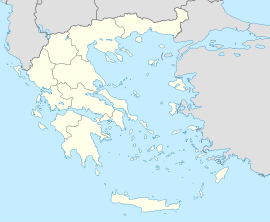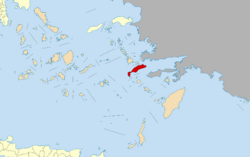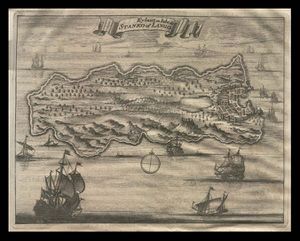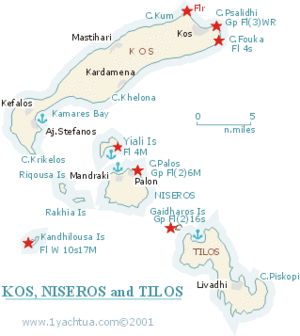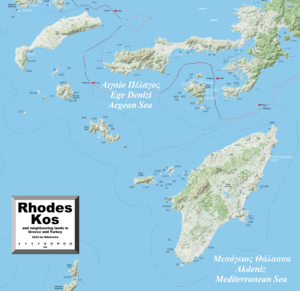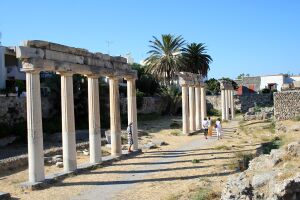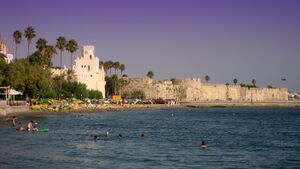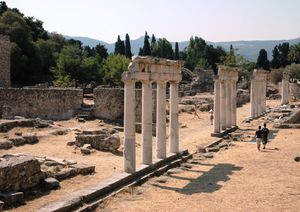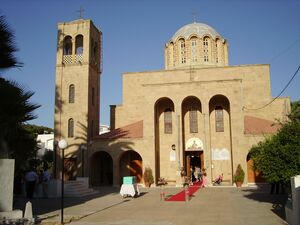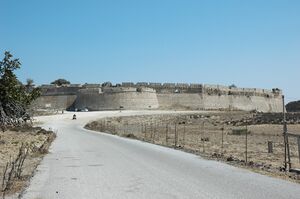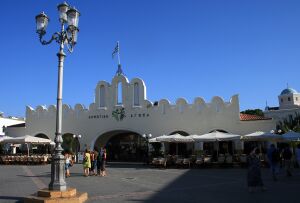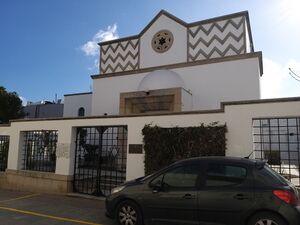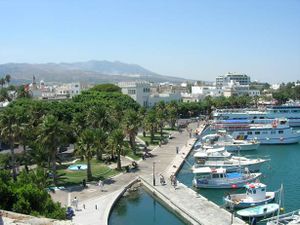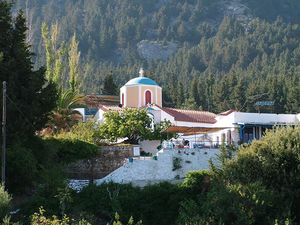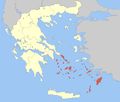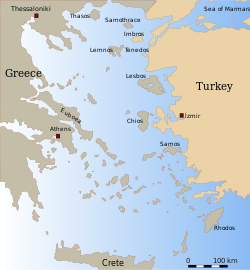كوس
Kos
Κως | |
|---|---|
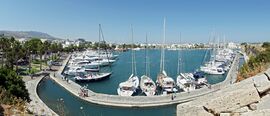 The harbour of Kos town | |
| الإحداثيات: 36°51′N 27°14′E / 36.850°N 27.233°ECoordinates: 36°51′N 27°14′E / 36.850°N 27.233°E | |
| البلد | |
| المنطقة الادارية | جنوب إيجة |
| الوحدة المحلية | كوس |
| المساحة | |
| • البلدية | 295٫3 كم² (114�0 ميل²) |
| • الوحدة البلدية | 67٫2 كم² (25٫9 ميل²) |
| أعلى منسوب | 843 m (2٬766 ft) |
| أوطى منسوب | 0 m (0 ft) |
| التعداد (2011)[1] | |
| • البلدية | 33٬387 |
| • كثافة البلدية | 110/km2 (290/sq mi) |
| • الوحدة البلدية | 19٬432 |
| • كثافة الوحدة البلدية | 290/km2 (750/sq mi) |
| صفة المواطن | Koan, Coan |
| منطقة التوقيت | UTC+2 (EET) |
| • الصيف (التوقيت الصيفي) | UTC+3 (EEST) |
| Postal code | 853 xx |
| مفتاح الهاتف | 22420 |
| Vehicle registration | ΚΧ, ΡΟ, PK |
| الموقع الإلكتروني | www.kos.gr |
كوس Kos أو Cos ( /kɒs,_kɔːs/؛ باليونانية: Κως [kos]؛ تركية: İstanköy)، هي جزيرة يونانية ضمن سلسلة جزر الجزر الاثنا عشرية، خلف خليج گوكاڤا. وتقدر مساحتها 40 كم x 8 كم، وتبعد حوالي 4 كم عن ساحل بودروم، تركيا، ومنطقة كاريا القديمة. وتتميز الجزيرة بالسهول الخصبة والأراضي الجبلة العالية ويصل عدد سكانها 30.947 نسمة. وتتألف الجزيرة من بلديات: كوس، المركز الإداري وأكبر بلدة (17.890 نسمة)، ديكايو، وإيراكليدس. Kos is the third largest island of the Dodecanese by area, after Rhodes and Karpathos; it has a population of 36,986[2] (2021 census), making it the second most populous of the Dodecanese, after Rhodes.[1] The island measures 42.1 by 11.5 kilometres (26 by 7 miles).[بحاجة لمصدر] Administratively, Kos constitutes a municipality within the Kos regional unit, which is part of the South Aegean region. The principal town of the island and seat of the municipality is Kos Town.[3]
. . . . . . . . . . . . . . . . . . . . . . . . . . . . . . . . . . . . . . . . . . . . . . . . . . . . . . . . . . . . . . . . . . . . . . . . . . . . . . . . . . . . . . . . . . . . . . . . . . . . . . . . . . . . . . . . . . . . . . . . . . . . . . . . . . . . . . . . . . . . . . . . . . . . . . . . . . . . . . . . . . . . . . . .
الاسم
The name Kos (باليونانية قديمة: Κῶς, genitive Κῶ)[4] is first attested in the Iliad, and has been in continuous use since. Other ancient names include Meropis,[5] Cea,[6] and Nymphaea.[7]
In many Romance languages, Kos was formerly known as Stancho, Stanchio, or Stinco, and in Ottoman and modern Turkish it is known as İstanköy, all from the reinterpretation of the Greek expression εις την Κω 'to Kos';[8] cf. the similar Istanbul and Stimpoli, Crete. Under the rule of the Knights Hospitaller of Rhodes, it was known as Lango or Langò, presumably because of its length.[9][10] In The Travels of Sir John Mandeville, the author misunderstands this and treats Lango and Kos as distinct islands.[11]
In Italian, the island is known as Coo.
A person from Kos is called a "Koan" (or "Coan") in English. The word is also an adjective, as in "Koan goods".[12]
الجغرافيا
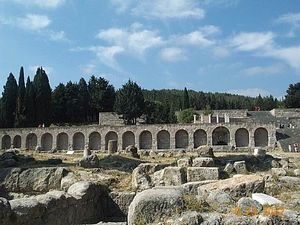
Kos is in the Aegean Sea. Its coastline is 112 kilometres (70 miles) long and it extends from west to east.
The island has several promontories, some with names known in antiquity: Cape Skandari, anciently Scandarium or Skandarion in the northeast;[13] Cape Lacter or Lakter in the south;[14] and Cape Drecanum or Drekanon in the west.[15]
In addition to the main town and port, also called Kos, the main villages of Kos island are Kardamena, Kefalos, Tingaki, Antimachia, Mastihari, Marmari and Pyli. Smaller ones are Zia, Zipari, Platani, Lagoudi and Asfendiou.
المناخ
Kos has a hot-summer Mediterranean climate.
| بيانات مناخ Kos Sewage Plant weather station (37m) | |||||||||||||
|---|---|---|---|---|---|---|---|---|---|---|---|---|---|
| الشهر | يناير | فبراير | مارس | أبريل | مايو | يونيو | يوليو | أغسطس | سبتمبر | اكتوبر | نوفمبر | ديسمبر | العام |
| العظمى المتوسطة °س (°ف) | 14.3 (57.7) |
15.5 (59.9) |
17.6 (63.7) |
20 (68) |
25 (77) |
28.5 (83.3) |
30.4 (86.7) |
31 (88) |
28.5 (83.3) |
25.7 (78.3) |
21.1 (70) |
17.4 (63.3) |
22٫92 (73٫25) |
| الصغرى المتوسطة °س (°ف) | 9 (48) |
10.1 (50.2) |
11.2 (52.2) |
12.9 (55.2) |
16.8 (62.2) |
20.9 (69.6) |
23.5 (74.3) |
24 (75) |
22.2 (72) |
19.6 (67.3) |
15.6 (60.1) |
12.3 (54.1) |
16٫5 (61٫7) |
| هطول mm (inches) | 214.7 (8.453) |
82.3 (3.24) |
68.2 (2.685) |
40.6 (1.598) |
7.2 (0.283) |
13.8 (0.543) |
0 (0) |
0 (0) |
5.2 (0.205) |
36.3 (1.429) |
106 (4.17) |
175.6 (6.913) |
749٫9 (29٫524) |
| Source: http://penteli.meteo.gr/stations/kos/ (2019 - 2020 averages) | |||||||||||||
البلدية
The present municipality of Kos was created in 2011 with the merger of three municipalities, which became municipal units:[3]
- Dikaios
- Irakleides
- Kos
The municipality has an area of 290,313 km2, and has a municipal unit of 67.200 km2.[16]
الاقتصاد
Tourism is the main industry in Kos,[17] the island's beaches being the primary attraction. The main port and population centre on the island, Kos town, is also a tourist and cultural centre, with whitewashed buildings including many hotels, restaurants and a number of nightclubs forming the town's "bar street". The seaside village of Kardamena is a popular resort for young holidaymakers (primarily from the United Kingdom and Scandinavia) and has a large number of bars and nightclubs.
Farming is the second principal occupation, with the main crops being grapes, almonds, figs, olives, and tomatoes, along with wheat and corn.[بحاجة لمصدر] Cos lettuce (romaine lettuce) is named after the island, from where it is said to have originated.[18][19]
الجيولوجيا
The island is part of a chain of mountains from which it became separated after earthquakes and subsidence that occurred in ancient times. The remnants of these mountains include the islands of Kalymnos and Kappari which are separated by an underwater chasm approximately 70 metres (230 ft; 38 fathoms) deep, as well as the volcano of Nisyros and the surrounding islands.
There is a wide variety of rocks in Kos which is related to its geographical formation. Prominent among these are the Quaternary layers in which the fossil remains of mammals such as horses, hippopotami and elephants have been found. The fossilised molar of an elephant of gigantic proportions was presented to the Paleontology Museum of the University of Athens.
التاريخ
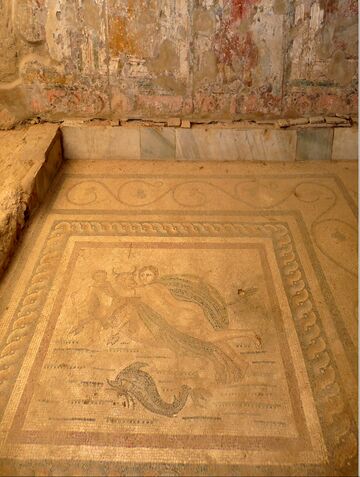
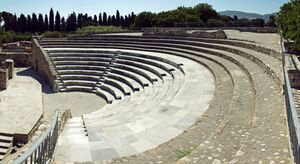
. . . . . . . . . . . . . . . . . . . . . . . . . . . . . . . . . . . . . . . . . . . . . . . . . . . . . . . . . . . . . . . . . . . . . . . . . . . . . . . . . . . . . . . . . . . . . . . . . . . . . . . . . . . . . . . . . . . . . . . . . . . . . . . . . . . . . . . . . . . . . . . . . . . . . . . . . . . . . . . . . . . . . . . .
العصر الموكني
In Homer's Iliad, a contingent of Koans fought for the Greeks in the Trojan War.[20]
In classical mythology the founder-king of Kos was Merops, hence "Meropian Kos" is included in the archaic Delian amphictyony listed in the 7th-century Homeric hymn to Delian Apollo; the island was visited by Heracles.[21] Kos was said to be the birthplace of the goddess Leto; the mother of Apollo.[22] Supposedly Leto's father Coeus was the first inhabitant of the island.[23]
The island was originally colonised by the Carians. The Dorians invaded it in the 11th century BC, establishing a Dorian colony with a large contingent of settlers from Epidaurus, whose Asclepius cult made their new home famous for its sanatoria. The other chief sources of the island's wealth lay in its wines and, in later days, in its silk manufacture.[24]
العصر العتيق
Its early history–as part of the religious-political amphictyonic league that included Lindos, Kamiros, Ialysos, Knidos and Halicarnassus, the Doric Hexapolis (hexapolis means 'six cities' in Greek),[25]–is obscure. At the end of the 6th century, Kos fell under Achaemenid domination but rebelled after the Greek victory at the Battle of Mycale in 479. Archaeological finds have shown the existence of a small shrine to Hemera and Helios; gods of the day and the Sun respectively.[26]
العصر الكلاسيكي
During the Greco-Persian Wars, before it twice expelled the Persians, it was ruled by Persian-appointed tyrants, but as a rule it seems to have been under oligarchic government. In the 5th century, it joined the Delian League, and, after the revolt of Rhodes, it served as the chief Athenian station in the south-eastern Aegean (411–407). In 366 BC, a democracy was instituted. In 366 BC, the capital was transferred from Astypalaea (at the west end of the island near the modern village of Kefalos) to the newly built town of Cos, laid out in a Hippodamian grid. After helping to weaken Athenian power, in the Social War (357-355 BC), it fell for a few years to the king Mausolus of Caria.
Proximity to the east gave the island first access to imported silk thread. Aristotle mentions silk weaving conducted by the women of the island.[27] Silk production of garments was conducted in large factories by female slaves.[28]
العصر الهليني
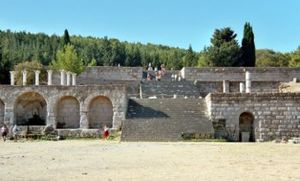
During the course of the Fourth War of the Diadochi Ptolemy I Soter captured Kos from Antigonus I Monophthalmus, incorporating it into his kingdom.[29] In the Hellenistic period, Kos attained the zenith of its prosperity. Kos was valued by the Ptolemies, who used it as a naval outpost to oversee the Aegean. As a seat of learning, it arose as a provincial branch of the museum of Alexandria, and became a favorite resort for the education of the princes of the Ptolemaic dynasty. During the Hellenistic age, there was a medical school; however, the theory that this school was founded by Hippocrates (see below) during the Classical age is an unwarranted extrapolation.[30] It was the home of the major Hellenistic poet-scholar Philitas.
Despite the incorporation of Kos to the Ptolemaic Kingdom, the island kept its political autonomy (shown in a 3rd-century BC decree found at Kos and well-studied by experts in Greek history).[31][32] The island was ruled autonomously through to its citizens' assembly and magistrates (the monarch, the prostates, the exegetes, etc). The fact that the city could legislate decrees and apply its own laws shows political independence regarding the Ptolemaic Kingdom. The city-state remained in control of its political institution and civil rights.
Kos also became a center of production of unrefined silk, oars and amphorae.[33] Kos economic development during the period can further be exemplified by the 3rd- and 2nd-century BC construction of a theater, a new market with multiple stoas, a temple to Apollo at Alisarna, construction and expansion of the Asclepeion, fortification works at Alisarna and multiple richly decorated houses.[34] In 240 BC, Ziaelas of Bithynia, Seleucus II Callinicus and Ptolemy III Euergetes provided guarantees for the transformation of Kos Asclepeion into an asylum. This decision made Kos a more attractive destination for merchants and pilgrims.[35]
Diodorus Siculus (xv. 76) and Strabo (xiv. 657) describe it as a well-fortified port. Its position gave it a high importance in Aegean trade; while the island itself was rich in wines of considerable fame.[36] Under Alexander the Great and the Ptolemies the town developed into one of the great centers in the Aegean; Josephus[37] quotes Strabo to the effect that Mithridates I of the Bosporus was sent to Kos to fetch the gold deposited there by queen Cleopatra of Egypt. Herod is said to have provided an annual stipend for the benefit of prize-winners in the athletic games,[38] and a statue was erected there to his son Herod the Tetrarch ("C. I. G." 2502 ). Paul briefly visited Kos according to Acts 21:1.
العصر الروماني
Except for occasional incursions by corsairs and some severe earthquakes, the island's peace has rarely been disturbed. Following the lead of its larger neighbour, Rhodes, Kos generally displayed a friendly attitude toward the Romans; in 53 AD it was made a free city. The island of Kos also featured a provincial library during the Roman period. The island first became a center for learning during the Ptolemaic dynasty, and Hippocrates, Apelles, Philitas and possibly Theocritus came from the area. An inscription lists people who made contributions to build the library in the 1st century AD.[39] One of the people responsible for the library's construction was the Kos doctor Gaius Stertinius Xenophon, who lived in Rome and was the personal physician of the Emperors Tiberius, Claudius, and Nero.[40]
Coae vestes
Older research believed that the island was known in antiquity for the manufacture of transparent light dresses, the coae vestes.[41] This view goes back to Aristotle, and it has been challenged by modern research. The term Coae vestes seems to refer to a type of silk garment and not the site of production (the island of Kos). The origin of the term is ultimately unclear.[42]
العصر البيزنطي
The bishopric of Kos was a suffragan of the metropolitan see of Rhodes.[43] Its bishop Meliphron attended the First Council of Nicaea in 325. Eddesius was one of the minority Eastern bishops who withdrew from the Council of Sardica in about 344 and set up a rival council at Philippopolis. Iulianus went to the synod held in Constantinople in 448 in preparation for the Council of Chalcedon of 451, in which he participated as a legate of Pope Leo I, and he was a signatory of the joint letter that the bishops of the Roman province of Insulae sent in 458 to Byzantine Emperor Leo I the Thracian with regard to the killing of Proterius of Alexandria. Dorotheus took part in a synod in 518. Georgius was a participant of the Third Council of Constantinople in 680–681. Constantinus went to the Photian Council of Constantinople (879).[44][45] Under Byzantine rule, apart from the participation of its bishops in councils, the island's history remains obscure. It was governed by a droungarios in the 8th–9th centuries, and seems to have acquired some importance in the 11th and 12th centuries: Nikephoros Melissenos began his uprising here, and in the middle of the 12th century, it was governed by a scion of the ruling Komnenos dynasty, Nikephoros Komnenos.[43]
Today the ecclesiastical metropolis of Kos remains under the direct authority of the Patriarchate of Constantinople, rather than the Church of Greece, and is also listed by the Catholic Church as a titular see.[46]
العصر الجنوي
Following the 11th century, Kos passed under Genoese control, although it was a bizantine territory and kept for a while by the Empire of Nicaea. Genoese ruled as protectorate and lasted over four centuries.[43] In the 1320s, Kos nominally formed part of the realm of Genoese Vignolo de Vignoli but then was attacked by Turkish corsairs until about the 16th century, and the Knights Hospitaller were hosted over the island paying a rent to Genoese republic.[43] The last Hospitaller governor of the island was Piero de Ponte. The island passed , on Hospitalier retractment, few more years back to Genoese rule, and then fell to Ottomans in 1566.
. . . . . . . . . . . . . . . . . . . . . . . . . . . . . . . . . . . . . . . . . . . . . . . . . . . . . . . . . . . . . . . . . . . . . . . . . . . . . . . . . . . . . . . . . . . . . . . . . . . . . . . . . . . . . . . . . . . . . . . . . . . . . . . . . . . . . . . . . . . . . . . . . . . . . . . . . . . . . . . . . . . . . . . .
العصر العثماني
The Ottoman Empire captured the island in early 1566.[43] The Ottomans ruled Kos until 1911.
During the course of the Orlov revolt, a Russian fleet anchored off the Kos castle. On the night of 5 August 1773, the Russians dispatched a landing party intending to capture the castle. They suffered heavy casualties in the ensuing battle and the Russian ships departed Kos two days later, having failed to achieve their objective.[47]
According to the Ottoman General Census of 1881/82–1893, the kaza of Kos (Istanköy) had a total population of 12,965, consisting of 10,459 Greeks, 2,439 Muslims and 67 Jews.[48]
الحكم الإيطالي
Kos was transferred to the Kingdom of Italy in 1912 after the Italo-Turkish War.[49] The Italians developed the infrastructures of the island, after the ruinous earthquake of 23 April 1933, which destroyed a great part of the old city and damaged many new buildings. Architect Rodolfo Petracco drew up the new city plan, transforming the old quarters into an archaeological park, and dividing the new city into a residential, an administrative, and a commercial area.,[50] In World War II, the island, as Italian possession, was part of the Axis. It was controlled by Italian troops until the Italian surrender in 1943. On that occasion, 100 Italian officers who had refused to join the Germans were executed in what became known as the Massacre of Kos. British and German forces then clashed for control of the island in the Battle of Kos as part of the Dodecanese Campaign, in which the Germans were victorious. German troops occupied the island until 1945, when it became a protectorate of the United Kingdom, which ceded it to Greece in 1947 following the Paris peace treaty.
السكان
السكان الأتراك
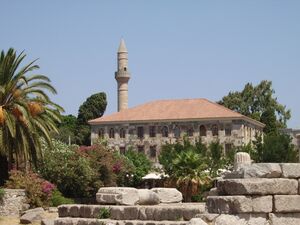
In the late 1920s about 3,700 Turks lived in Kos city, slightly less than 50% of the population, who settled mainly in the west part of the city.[51] Today, the population of the Turkish community in Kos has been estimated at about 2,000 people.[52][53] A village with significant Turkish population is Platani (Kermentes) near the town of Kos.
الدين
The people of Kos are predominantly Orthodox Christians – one of the four Orthodox cathedrals in the Dodecanese is located in Kos. In addition, there is a Roman Catholic church on the island and a mosque for the Turkish-speaking Muslim community. The synagogue is no longer used for religious ceremonies as the Jewish community of Kos was targeted and destroyed by occupying German forces in World War II. It has, however, been restored and is maintained with all religious symbols intact and is now used by the Municipality of Kos for various events, mainly cultural.
المعالم الرئيسية
القلاع
The island has a 14th-century fortress at the entrance to its harbour, erected in 1315 by the Knights Hospitaller، وآخر من الفترة البيزنطية في أنتيماخيا.
الأگورا القديمة
The ancient market place of Kos was considered one of the biggest in the ancient world. It was the commercial and commanding centre at the heart of the ancient city. It was organized around a spacious rectangular yard 50 metres (160 ft) wide and 300 metres (980 ft) long. It began in the Northern area and ended up south on the central road (Decumanus) which went through the city. The northern side connected to the city wall towards the entrance to the harbour. Here there was a monumental entrance. On the eastern side there were shops. In the first half of the 2nd century BC, the building was extended toward the interior yard. The building was destroyed in an earthquake in 469 AD.
In the southern end of the market, there was a round building with a Roman dome and a workshop which produced pigments including Egyptian Blue. Coins, treasures, and copper statues from Roman times were later uncovered by archaeologists. In the western side excavations led to the findings of rooms with mosaic floors which showed beastfights, a theme quite popular in Kos.[54]
الكنيس
The synagogue Kahal Shalom of Kos, on 4, Alexandrou Diakou street in the historic city center, was built in 1935. It was designed by architects Armando Bernabiti and Rodolfo Petracco, and was built by the construction company 'De Martis-Sardelli'.[55] The synagogue complex includes the synagogue and the adjacent rabbi's residence, today housing the offices of the organization 'Hippocrates'. The Jewish community of Kos dates from antiquity. An older synagogue was destroyed in the earthquake of April 13, 1933. The new synagogue was constructed in 1935.[56] Following the deportation of nearly 100 members of the Jewish community on Sunday July 23, 1944, the synagogue was abandoned and later purchased by the Municipality in the 1980s. The synagogue has been used as a cultural center by the Municipality of Kos, for lectures and exhibitions. In 2022 the Municipality of Kos and the Central Board of Jewish Communities, commissioned architect Elias V. Messinas to restore the interior of the synagogue, and make possible a dual use of the building for religious services, and cultural activities.
الثقافة
he ancient physician Hippocrates is thought to have been born on Kos, and in the center of the town is the Plane Tree of Hippocrates, a dream temple where the physician is traditionally supposed to have taught. The limbs of the now elderly tree are supported by scaffolding. The small city is also home to the International Hippocratic Foundation of Kos and the Hippocratic Museum dedicated to him. Near the Institute are the ruins of Asklepieion, where Herodicus taught Hippocrates medicine.
مشاهير كوس
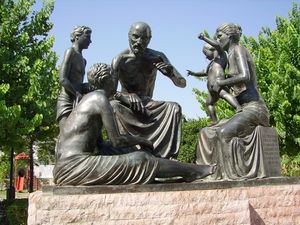
- Epicharmus of Kos (6th–5th century BC), comic playwright
- أبقراط (القرن 5 ق.م.), "أبو الطب"
- آپلس رسام (القرن 4 ق.م.)
- Philitas of Cos (4th century BC), poet and scholar.
- Ptolemy II Philadelphus (4th century BC) Pharaoh of the Ptolemaic Kingdom
- Michael Kefalianos, professional bodybuilder.[57]
- ماريكا پاپاگيكا (early 20th century) singer.[58]
- Kostas Skandalidis, former Interior Minister of Greece and close associate of Prime Minister Andreas Papandreou.[59]
- آل كامپانيس (القرن 20) Major League Baseball player and executive.[60]
- Stergos Marinos, former professional footballer.[61]
- Şükrü Kaya, Turkish politician, who served as Minister of the Interior and Minister of Foreign Affairs of Turkey. He was one of the perpetrators of the Armenian genocide.[62]
النقل
في الثقافة الشعبية
Kos is the setting of the wargaming book 'Swords of Kos Fantasy Campaign Setting', written by Michael O. Varhola with co-authors.[63]
معرض
انظر أيضا
- قائمة براكين اليونان
- قائمة جزر اليونان
- Coan wine
- List of volcanoes in Greece
- List of islands of Greece#Dodecanes islands
- The disappearance of Ben Needham in 1991.
المراجع
- ^ أ ب ت "Απογραφή Πληθυσμού - Κατοικιών 2011. ΜΟΝΙΜΟΣ Πληθυσμός" (in اليونانية). Hellenic Statistical Authority.
- ^ (PDF) https://elstat-outsourcers.statistics.gr/Census2022_GR.pdf.
{{cite web}}: Missing or empty|title=(help) - ^ أ ب "ΦΕΚ A 87/2010, Kallikratis reform law text" (in اليونانية). Government Gazette.
- ^ Liddell et al., A Greek–English Lexicon, s.v.
- ^ توكيديدس. تاريخ الحرب الپلوپونيزية. Vol. 8.41.
- ^ Pliny cites Staphylus of Naucratis for this name in the Natural History 5:36 Archived 24 سبتمبر 2015 at the Wayback Machine, but Peck apparently misinterprets Staphylus as a name of Kos
- ^ Harry Thurston Peck, Harper's Dictionary of Classical Antiquities, 1898, s.v. Cos Archived 16 أكتوبر 2014 at the Wayback Machine
- ^ C.S. Sonnini, Travels in Greece and Turkey, undertaken by order of Louis XVI, and with the authority of the Ottoman court, London, 1801, 1 p. 212
- ^ A handbook for travellers in Greece, Murray's Handbooks, 4th edition, London, 1872, p. 364
- ^ H.J.A. Sire, The Knights of Malta, Yale, 1996, ISBN 0300068859, p. 34
- ^ Anthony Bale, trans., The Book of Marvels and Travels, Oxford 2012, ISBN 0199600600, p. 15 and footnote
- ^ Kos Island Today Archived 29 أغسطس 2010 at the Wayback Machine. Kosisland.gr.
- ^ قالب:Cite DARE
- ^ قالب:Cite DARE
- ^ قالب:Cite DARE
- ^ "Population & housing census 2001 (incl. area and average elevation)" (PDF) (in اليونانية). National Statistical Service of Greece. Archived from the original (PDF) on 21 September 2015.
- ^ "Kos weather". Met Office (in الإنجليزية). Retrieved 2021-02-12.
- ^ "Cos". Oxford English Dictionary (Online ed.). Oxford University Press. Retrieved 27 September 2020. قالب:OEDsub "Etymology: The name (Greek Κῶς) of an island in the Ægean." "In full cos lettuce. A variety of lettuce introduced from the island of Cos.
- ^ Rupp, Rebecca (13 August 2015). "From Ancient Egypt to Outer Space, the Delicious History of Lettuce". National Geographic.
- ^ Iliad ii.676, from "Kos, the city of Eurypylus, and the Calydnae isles", under the leaders Phidippos and Antiphos, "sons of the Thessalian king". It is unclear whether Homer is describing cultural affiliations of his own time or remembered traditions of Mycenaean times.
- ^ Hercules in Kos Archived 29 أكتوبر 2010 at the Wayback Machine. Kosinfo.gr.
- ^ Herodas (2009). Mimiambs. Translated by Graham Zanker. Oxbow Books. p. 65. ISBN 978-0-85668-883-6.
- ^ Tacitus, The Annals 12.61
- ^ Money, Power And Gender:Evidence For Influential Women Represented And Sculpture On Kos Archived 20 يوليو 2011 at the Wayback Machine. None.
- ^ The Princeton Encyclopedia of Classical Sites (eds. Richard Stillwell, et al.), s.v. "Kos".
- ^ Farnell, Lewis Richard (1909). The Cults of the Greek States volume V. Oxford: Clarendon Press. p. 419.
- ^ A Treatise on the Origin, Progressive Improvement, and Present State of the Silk Manufacture في كتب گوگل
- ^ Introduction to the New Testament, p. 83, في كتب گوگل
- ^ Sartre 2006, pp. 55–56.
- ^ Vincenzo Di Benedetto: Cos e Cnido, in: Hippocratica - Actes du Colloque hippocratique de Paris 4-9 septembre 1978, ed. M. D. Grmek, Paris 1980, 97-111, see also Antoine Thivel: Cnide et Cos ? : essai sur les doctrines médicales dans la collection hippocratique, Paris 1981 (passim), ISBN 22-51-62021-4; cf. the review by Otta Wenskus (on JSTOR).
- ^ Te Riele, G.-J.-M.-J. (1966). "F. SOKOLOWSKI, Lois sacrées des cités grecques (École française d'Athènes. Travaux et mémoires des anciens membres étrangers de l'école et de divers savants, 11). Paris, E. de Boccard, 1962. 244 p. Pr. F 54.-". Mnemosyne. 19 (2): 208–210. doi:10.1163/156852566x00303. ISSN 0026-7074.
- ^ Hansen, P. A. (April 1994). "Brigitte Le Gune-Pollet: La vie religieuse dans le monde grec du e au IIIe Sieècle avant notre ère: Choix de documents èpigraphiques traduits et commentés. (amphi, 7.) Pp. 256. Toulouse: Presses Universitaires du Mirail, 1991. Paper, frs. 90". The Classical Review. 44 (1): 222. doi:10.1017/s0009840x00291555. ISSN 0009-840X.
- ^ Sartre 2006, pp. 251–254.
- ^ Sartre 2006, pp. 274–275.
- ^ Sartre 2006, pp. 267–269.
- ^ Pliny, xxxv. 46
- ^ "Ant." xiv. 7, § 2
- ^ Josephus, "B. J." i. 21, § 11
- ^ "Libraries of Greece". Annette Lamb. Archived from the original on 21 فبراير 2015. Retrieved 28 مارس 2015.
- ^ "The Asklepion of Kos – Home of Modern Medicine". The Skibbereen Eagle. Archived from the original on 2 أبريل 2015. Retrieved 28 مارس 2015.
- ^
 Smith, William, ed. (1854). "Cos". Dictionary of Greek and Roman Geography. Vol. 1. London: John Murray.
Smith, William, ed. (1854). "Cos". Dictionary of Greek and Roman Geography. Vol. 1. London: John Murray.
- ^ Radicke, Jan (2022). 9 vestes Melitenses, vestes Coae, cyclas, gausapum – fashion and the Empire (in الإنجليزية). Berlin: De Gruyter. pp. 386–391. doi:10.1515/9783110711554-025. ISBN 978-3-11-071155-4.
- ^ أ ب ت ث ج Gregory, Timothy E. (1991). "Kos". In Kazhdan, Alexander (ed.). The Oxford Dictionary of Byzantium. Oxford and New York: Oxford University Press. p. 1150. ISBN 978-0-19-504652-6.
- ^ Raymond Janin, v. Cos in Dictionnaire d'Histoire et de Géographie ecclésiastiques, vol. XIII, Paris 1956, coll. 927-928
- ^ Pius Bonifacius Gams, Series episcoporum Ecclesiae Catholicae Archived 8 مارس 2015 at Wikiwix, Leipzig 1931, p. 448
- ^ Annuario Pontificio 2013 (Libreria Editrice Vaticana 2013 ISBN 978-88-209-9070-1), p. 875
- ^ Hatzivasileiou, Vasilis (1990). Ἱστορία τῆς νήσου Κῶ : Ἀρχαία, μεσαιωνική, νεότερη [History of Kos Island: Ancient, Medieval, Modern] (in اليونانية). Athens: Dimos Ko. p. 314.
- ^ Kemal Karpat (1985), Ottoman Population, 1830-1914, Demographic and Social Characteristics, The University of Wisconsin Press, pp. 130–131
- ^ Bertarelli, Luigi Vittorio (1929). Guida d'Italia Vol. XVII. Milano: C.T.I. p. Sub voce "Storia".
- ^ G. Rocco, M. Livadiotti, Il piano regolatore di Kos del 1934: un progetto di città archeologica, "Thiasos", 1, 2012, pp. 10-2 Archived 28 يوليو 2014 at the Wayback Machine
- ^ Bertarelli, Luigi Vittorio (1929). Guida d'Italia, Vol. XVII (1st ed.). Milano: CTI. p. 145.
- ^ Ürkek bir siyasetin tarih önündeki ağır vebali, p. 142, في كتب گوگل
- ^ "MUM GİBİ ERİYORLAR". www.batitrakya.4mg.com. Archived from the original on 1 يوليو 2017. Retrieved 2 مايو 2018.
- ^ Ancient Sites of the Harbour and Market Place Archived 29 أكتوبر 2010 at the Wayback Machine. Kosinfo.gr.
- ^ The Historic and Folklore Archive of the Municipality of Kos. (2022)
- ^ E.V. Messinas, The Synagogues of Greece: A Study of Synagogues in Macedonia and Thrace: With Architectural Drawings of all Synagogues of Greece, KDP, 2022, ISBN 979-8-8069-0288-8, p. 171-174
- ^ Michael Kefalianos – Bio Archived 22 يناير 2015 at the Wayback Machine MichaelKefalianos.com
- ^ Steve Sullivan (4 October 2013). Encyclopedia of Great Popular Song Recordings. Scarecrow Press. p. 742. ISBN 978-0-8108-8296-6.
- ^ Administrator. "Σκανδαλίδης Κώστας - Βιογραφικό". www.skandalidis.gr. Archived from the original on 16 يوليو 2017. Retrieved 2 مايو 2018.
- ^ "www.baseball-reference.com". baseball-reference.com. Archived from the original on 4 مارس 2016. Retrieved 2 مايو 2018.
- ^ "Stergos Marinos biography" (in اليونانية). Stergos Marinos' official website. Archived from the original on 22 مارس 2014. Retrieved 13 أبريل 2012.
- ^ Who is who database - Biography of Şükrü Kaya Archived 5 يونيو 2015 at the Wayback Machine (in Turkish)
- ^ Varhola, Michael O.; Clunie, Jim; Cass, Brendan; Staples, Clint; Thrasher, William T.; Van Deeleen, Chris; Farnden, Heath (2016). Swords of Kos Fantasy Campaign Setting. Skirmisher Publishing. ISBN 978-1935050742. Retrieved 31 January 2020.
المصادر
- Sartre, Maurice (2006). Ελληνιστική Μικρασία: Aπο το Αιγαίο ως τον Καύκασο [Hellenistic Asia Minor: From the Aegean to the Caucasus] (in اليونانية). Athens: Ekdoseis Pataki. ISBN 9789601617565.
وصلات خارجية
 Kos travel guide from Wikivoyage
Kos travel guide from Wikivoyage
- CS1 اليونانية-language sources (el)
- CS1 errors: missing title
- CS1 errors: bare URL
- Wikipedia articles incorporating a citation from the DGRG without Wikisource reference
- Webarchive template other archives
- Short description is different from Wikidata
- Coordinates on Wikidata
- صفحات تستخدم جدول مستوطنة بقائمة محتملة لصفات المواطن
- Articles containing Greek-language text
- مقالات ذات عبارات بحاجة لمصادر
- Articles containing Ancient Greek (to 1453)-language text
- Articles containing إيطالية-language text
- Articles with unsourced statements from October 2013
- المقالات needing additional references from December 2022
- كل المقالات needing additional references
- Articles containing لاتينية-language text
- Articles containing أوتورو-language text
- Articles with hatnote templates targeting a nonexistent page
- كوس
- Dodecanese
- Islands of the South Aegean
- Landforms of Kos (regional unit)
- Landforms of the South Aegean
- Municipalities of the South Aegean
- Subduction volcanoes
- Volcanoes of Greece
- Volcanoes of the Aegean
- Locations in the Iliad
- New Testament places
- Populated places in Kos (regional unit)
- جزر اليونان
- السياحة في اليونان
- براكين اليونان
- براكين إيجه
- Dorian Hexapolis
- تجمعات تركية خارج تركيا

